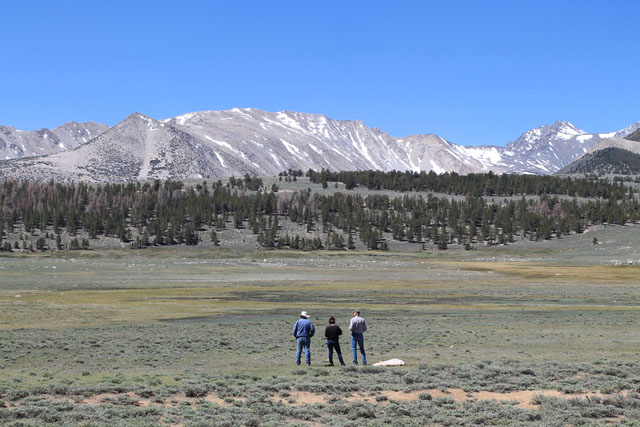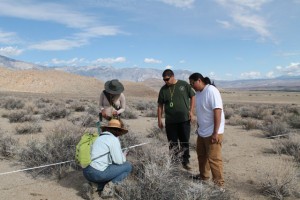CSUN Interdisciplinary Researchers Study Owens Valley History

CSUN students take participatory geographic data as part of the Owens Valley research project. Photo provided by Kim Kirner.
The Owens Valley is one of Los Angeles’ main water sources — pumping water to the region for the past 100 years. But at what cost to the valley’s people?
A team of California State University, Northridge anthropology, botany and environmental science professors are studying the environmental and human impacts on Owens Valley plant life over the past 50 years. The project looks at the numbers — measuring changes in the diversity of plants and water usage — as well as the perspective of Owens Valley residents on those changes, said anthropology professor Kim Kirner.
“It’s one thing to talk about what is actually happening on the ground, and it’s another thing to talk about how people experience that — and the ways they respond to it and impact their [life],” Kirner said.
By incorporating historical documents on water policy and the Owens Valley over the past 50 years combined with interviews of residents of the area, Kirner and the team are painting a picture of valley residents’ changing perspectives over time. She said some results would be ready to share by December 2015.
“We are trying to understand the human side of things,” she said. “Are there gaps [in] how agencies study and think about decisions they make versus the way that local people on the ground perceive change?”

CSUN botany professor Paula Schiffman, left, demonstrates how to take vegetation samples from Owens Valley to students. Photo provided by Kim Kirner.
Satellite data and information gathered by CSUN botanist Paula Schiffman on the ground will allow the team to analyze empirical data and determine how much Owens Valley’s biodiversity has changed, then correlate the data with water policy changes. Kirner said she hopes to open Los Angeles residents’ eyes to the impact their water usage has on plant diversity, during a drought or otherwise.
“All over the American West, urban areas are tied to rural water sources. We’ve built urban development off of rural water availability,” she said. “We’ve taken resources from the rural areas, and we funnel them into cities. This has increasingly caused challenges. Scientists think we are heading into serious problems. [For example], there are places in Owens Valley that have high brush tree death rates now, [which hasn’t been seen to this extent before].”
Kirner and her team also are incorporating a participatory geographic aspect in the project, where members of the Owens Valley community — including members of the indigenous Paiute tribe — can post pictures and tell their stories online.
“We are looking at how [people] — cattle ranchers, the Paiute people, who have been there for quite some time, older people — perceive changes over the course of their lifetime,” she said.
“I want to see how people’s life ways and heritage have been impacted,” Kirner continued.
“Can Paiute people still go find traditional foods and basketry material? Does it become a struggle for ranchers to maintain their way of life and pass it on to their children?”
The most important part of the project, for Kirner, is being able to better understand the perspectives of water policy makers and the general community in the Owens Valley, and see how the actual numbers can help make a difference for both parties.

CSUN environment science students look at archives of Owens Valley water policy. Photo provided by Kim Kirner.
“We are trying to understand the human side of things,” she said. “Are there gaps [in] how agencies study and think about things and the kind of decisions they make — and the way that local people on the ground perceive change and contribute causal factors to change?
“We hope to build synergy around this project. [There may be] issues of people understanding the water problems in Owens Valley. We hope that by them engaging in it and feeling that their voices are heard, they know they can do something.”

 experience
experience